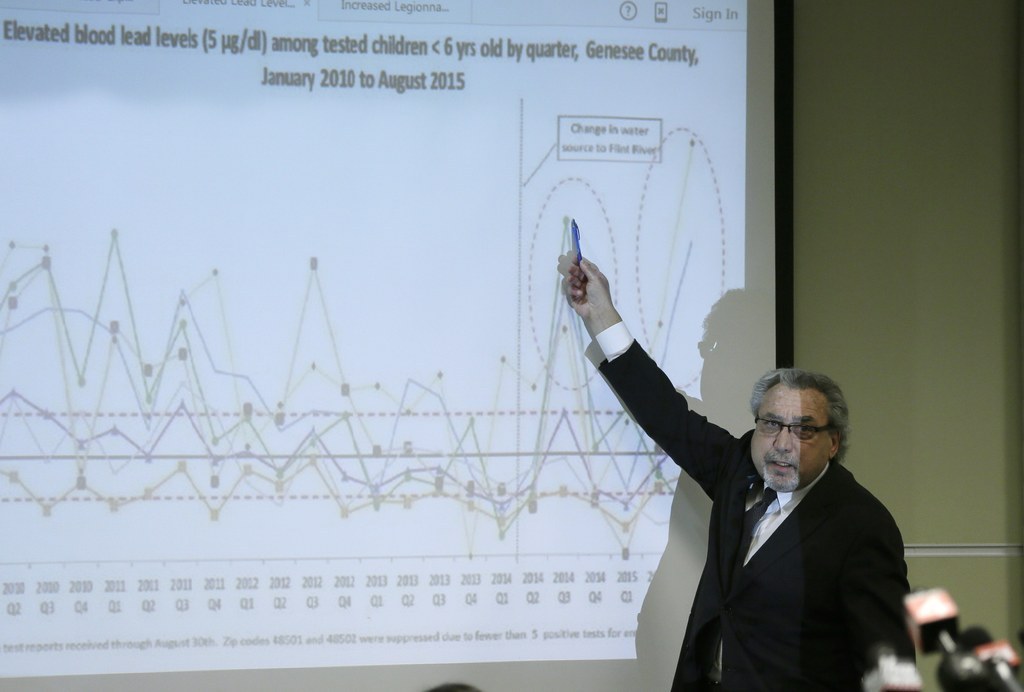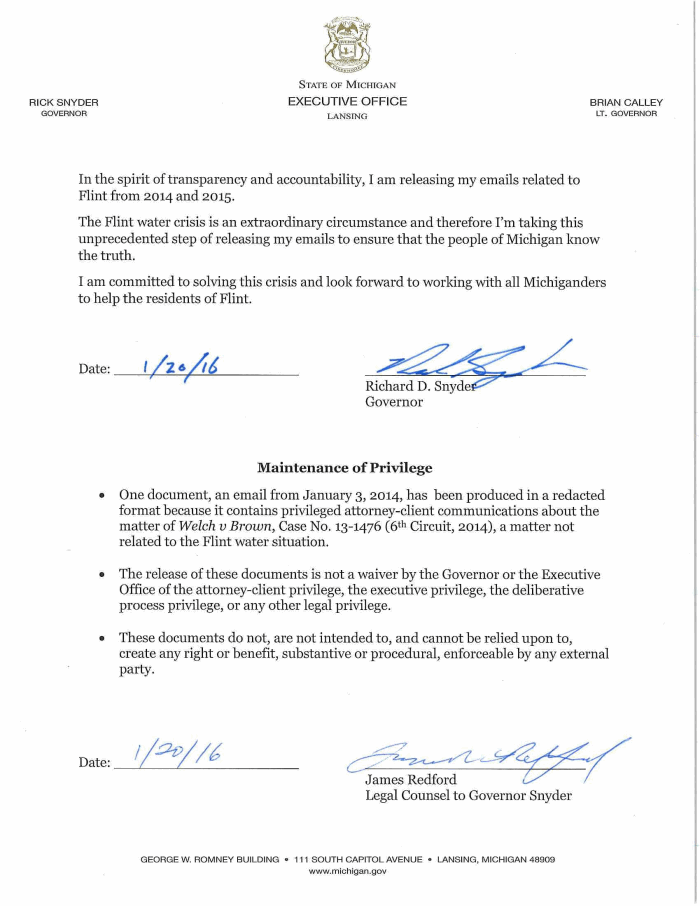
Michigan Gov. Rick Snyder on Wednesday released a collection of emails dating back to January 2014 that detail the communication among government officials as the Flint water crisis unfolded.
Residents in the city of just over 100,000 people — most of whom are black and working-class — were subjected to massive lead contamination in the municipal water supply after the city stopped sourcing from Detroit and switched to the Flint River in April 2014. Children have since tested positive for elevated levels of lead in their blood.
President Obama declared an emergency on Jan. 16, telling reporters that he "would be beside myself" as a parent to discover the health risks the public water presented.
Snyder released the correspondences in "the spirit of transparency and accountability," but the 274 pages of emails between state officials about the increasingly unsafe water running through Flint's pipes shows a concerted effort to eschew responsibility.
BuzzFeed News has read through the emails and summarized the most striking findings.
When the City of Flint announced on April 25, 2014, that it would begin sourcing its water from the Flint River instead of from the Detroit Water and Sewage Department (DWSD), citing a state official who said the water was safe to drink.

However, in the same statement, officials acknowledged "some lingering uncertainty about the quality of the water."
In order to "dispel myths" about the water's questionable drinkability, the city conducted tests and studies by independent organizations, none of which were cited in the official announcement.
Mike Glasgow, who has worked for the City of Flint Water Service Center for nearly 10 years, said he had never detected abnormalities in the city's drinking water.
And according to Michigan Department of Public Works Director Howard Croft, the test results showed that the water was not only safe, "but of the high quality that Flint customers have come to respect."
But a Department of Environmental Quality (DEQ) briefing sent on Oct. 1, 2014 pointed to several troubling factors, ranging from infrastructure to a shrinking population.
The memo was regarding two Boil Water Advisories issued for Flint in August and September that year traces of E. coli were detected in the water.
The department cited possible factors for the advisories, including the Flint's 75-year-old cast iron pipes, which are prone to corrosion and "biofilm growth." The DEQ also noted Flint's shrinking population, which leads to the water supply spending more time distribution pipes and water storage facilities, accelerating corrosion.
Cold winter conditions were also causing pipe break and leaks, while warmer weather was promoting bacterial growth, the department warned.

A Feb. 1, 2015, email briefing Snyder ahead of an event in Flint suggested he reiterate the scope of relief efforts, and appeared to downplay the severity of public concerns.
Referring to the unsafe water quality as the "Flint situation," the correspondence noted that it had been a "high-profile concern in recent weeks, with residents complaining about the color, taste, and smell of tap water," and one representative stating that his constituents were "on the verge of civil unrest."
The possibility of water contamination by a bladder cancer-causing bacteria was a mounting concern, but the memo noted "it's not like an eminent threat to public health."
Residents had also voiced discomfort with the color of their water, which had already started to brown. As one official noted, it was "clear folks in Flint are concerned about other aspects of their water — taste, smell, and color being among the top complaints."
Snyder was also advised to recall the parameters of the Safe Drinking Water Act, which is meant to "ensure that water is safe to drink," but that it "does not regulate the aesthetic values of water."
The official remarked that former Flint Mayor Dwayne Walling had "seized on this public panic" to advocate for a loan forgiveness from the state.
Even after Flint residents began to exhibit abnormally high levels of lead in their blood, a Sept. 24 email highlighting talking points for Snyder cited the normalcy of “seasonal exposure” to lead.
Officials pointed to children's increased contact with soil and outdoor paint during the summer months to the higher presence of lead in their blood.
The briefing also emphasized that the "replacement of service pipes on private property and any leaded plumbing materials within the home is the homeowner's responsibility."
State officials also accused the Flint’s government of “playing political football” with the lead exposure issue, and charged residents with “looking for someone to blame” in emails dated Sept. 25 and 26.

Snyder's chief of staff wrote that state environmental health officials felt that "some in Flint are taking the very sensitive issue of children's exposure to lead and trying to turn it into political football claiming the departments are underestimating the impacts on the populations and particularly trying to shift responsibility to the state."
The official added that the "real responsibility" rests with the county, city, and the Karegnondi Water Authority.
And while another email acknowledged "occasional less than savory aspects" of the water, those who voiced their concerns about lead levels were referred to as "the anti everything committee."
Then two emails on Oct. 18 reveal the state's oversight of an assessment by Miguel Del Toral, a water expert from the Environmental Protection Agency (EPA).

Months earlier, Deltoral had expressed concerns with the way the state had conducted its water tests in Flint. He suggested that the methods, which involved flushing the water before testing it, may have skewed the lead measurements.
"Folks tend to discount these values as anomalies, but particulate lead release is a normal part of the corrosion process and it is universal (common) in all systems. It's just that it's not captured as often by the infrequent LCR sampling.
If systems are pre-flushing the tap the night before collecting LCR compliance samples (MDEQ still provides these instructions to public water systems) this clears particulate lead out of the plumbing and biases the results low by eliminating the highest lead values."
"The city can't just flush in advance of taking the compliance samples, they have to flush the lines on a regular basis," he added.
Deltoral had sent another email in April detailing his concerns.
"Given the very high lead levels found at one home and the pre-flushing happening in Flint, I'm worried that the whole town may have much higher lead levels than the compliance results indicated," he wrote.
BuzzFeed News has reached out to Del Toral for more information.
By year's end, the Flint Water Advisory Task Force wrote a letter accusing the Department of Environmental Quality of failing to effectively handle the situation.
The task force, which was appointed by Snyder, reached out to him on Dec. 29, 2015.
"We believe the primary responsibility for what happened in Flint rests with the Michigan Department of Environmental Quality (MDEQ). Although many individuals and entities at state and local levels contributed to creating and prolonging the problem, MDEQ is the government agency that has responsibility to ensure safe drinking water in Michigan. it failed in that responsibility and must be held accountable for that failure."
This week, Snyder addressed the crisis head-on in his annual address to state lawmakers.
"To you, the people of Flint, I say tonight as I have before, I am sorry and I will fix it," Snyder said. "No citizen of this great state should endure this kind of catastrophe. Government failed you — federal, state and local leaders — by breaking the trust you place in us."

